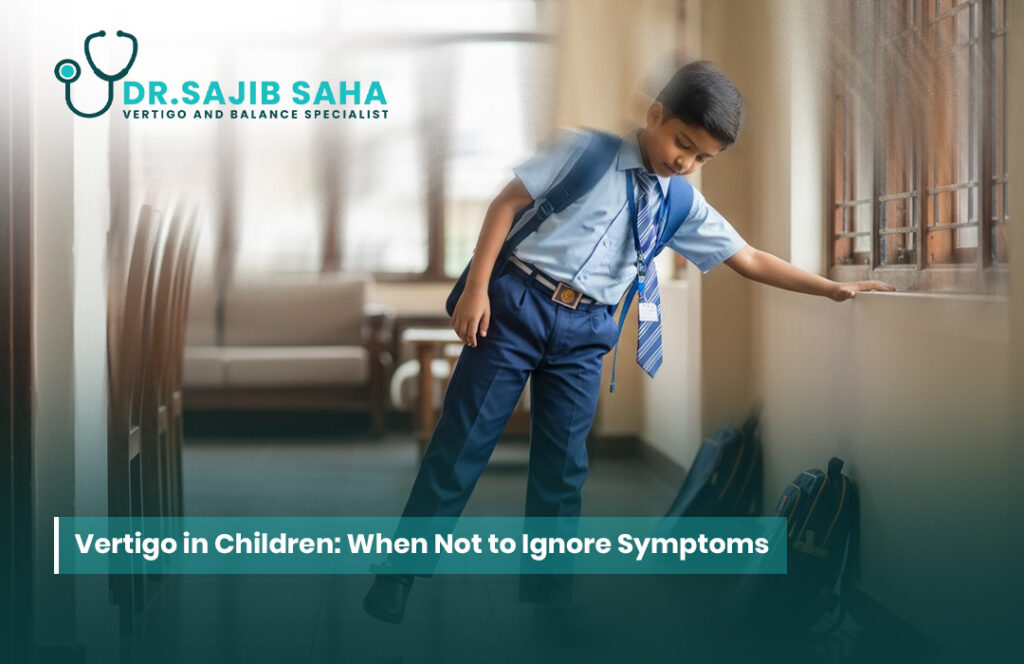Vertigo is a sensation of spinning, tilting, or feeling off-balance. Children with vertigo may describe it as “the room is moving” or “I feel like I’m floating.” Unlike normal dizziness from fatigue or dehydration, vertigo is often linked to disturbances in the inner ear or vestibular system, which controls balance and spatial orientation.
Common Symptoms of Vertigo in Children
Recognizing vertigo early is crucial. Children may not always articulate their symptoms clearly, but common signs include:
-
Spinning sensation or imbalance
-
Frequent falls or clumsiness
-
Nausea or vomiting
-
Headaches or migraines
-
Sensitivity to motion
-
Difficulty walking or holding objects steady
-
Unusual eye movements (nystagmus)
Tip for parents: Keep a symptom diary noting when episodes occur, their duration, and triggers. This information helps doctors make a precise diagnosis.
Causes of Vertigo in Children
Vertigo in children can arise from various factors. Some of the most common include:
1. Benign Paroxysmal Vertigo of Childhood (BPVC)
-
Sudden, brief episodes of vertigo
-
Often occurs in children aged 2–6 years
-
Usually resolves by age 8
-
May be associated with family history of migraines
2. Vestibular Migraine
-
Headaches accompanied by dizziness
-
Often linked to nausea and visual disturbances
-
Can affect school performance due to frequent episodes
3. Inner Ear Infections
-
Otitis media (middle ear infection) can disrupt balance
-
Vertigo may be accompanied by ear pain or fever
4. Trauma
-
Head injuries or falls can affect the vestibular system
-
Persistent vertigo post-injury should always be evaluated
5. Other Causes
-
Rare neurological conditions
-
Medication side effects
-
Metabolic or systemic disorders
When to Seek Medical Help
While some dizziness may be benign, certain signs should never be ignored:
-
Vertigo lasting more than a few minutes
-
Persistent vomiting
-
Severe headache or eye movement abnormalities
-
Difficulty walking or speaking
-
Hearing loss or ringing in the ears
-
Loss of consciousness
Early intervention is key to prevent complications, support development, and maintain your child’s safety.
Diagnosis of Vertigo in Children
Diagnosing vertigo in children requires a comprehensive evaluation. Dr. Sajib Saha, a specialist in balance disorders, follows a step-by-step approach:
-
Medical History: Reviewing symptom patterns, family history, and recent illnesses
-
Physical Examination: Assessing balance, coordination, and eye movements
-
Vestibular Tests: Tests like VNG (Videonystagmography) or caloric testing evaluate inner ear function
-
Imaging (if needed): MRI or CT scans to rule out neurological causes
Treatment Options for Pediatric Vertigo
Treatment depends on the underlying cause. Common approaches include:
1. Vestibular Rehabilitation Therapy
-
Exercises to improve balance and coordination
-
Helps retrain the brain to adapt to inner ear dysfunction
2. Medication
-
Anti-nausea or migraine medications may be prescribed for specific conditions
-
Always guided by a pediatric ENT or neurologist
3. Lifestyle Modifications
-
Adequate hydration
-
Balanced diet
-
Regular sleep patterns
-
Limiting screen time during vertigo episodes
4. Surgical Intervention (Rare Cases)
-
Only for structural inner ear issues or severe vestibular disorders
Tips for Parents to Support Their Children
-
Monitor episodes carefully: Note triggers and duration
-
Provide a safe environment: Prevent falls during dizzy spells
-
Educate your child: Teach them to sit or lie down when feeling dizzy
-
Regular check-ups: Schedule follow-ups with a pediatric ENT or vestibular specialist
Conclusion
Vertigo in children is not always harmless. Early recognition, proper diagnosis, and timely treatment are essential to safeguard your child’s health and development. Parents should remain vigilant and consult specialists like Dr. Sajib Saha if they notice recurrent or severe symptoms.
With proper care, most children recover fully, regaining their balance and confidence in everyday activities. Don’t ignore persistent dizziness—early intervention can make all the difference.
